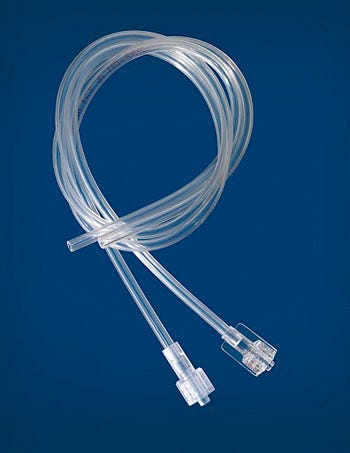A medical-grade elastomer was extruded into thin-wall tubing at rates up to 830 ft/minute, showcasing a speedy alternative to polyvinyl chloride (PVC). Extruder manufacturer American Kuhne ran Teknor Apex's Medalist medical elastomer in a 0.105 inch (2.67-mm) outer diameter by 0.020 inch (0.508-mm) wall tube.
July 18, 2011
A medical-grade elastomer was extruded into thin-wall tubing at rates up to 830 ft/minute, showcasing a speedy alternative to polyvinyl chloride (PVC). Extruder manufacturer American Kuhne ran Teknor Apex's Medalist medical elastomer in a 0.105 inch (2.67-mm) outer diameter by 0.020 inch (0.508-mm) wall tube. The companies noted that at speeds up to 600 ft/min (183 meters/min), tolerances of ± 0.0004 inch on the outer diameter and ±0.0001 inch on the wall thickness were held.
Medalist elastomer-based tubing |
|
|
The extrusion system consisted of an American Kuhne Ultra series 2-inch (50-mm) extruder with an AKcess Level II touchscreen control and inline spiral flow die head. Downstream, the cell ran a Conair multi-pass vacuum tank with servodriven wheel to minimize the "rubber-band effect" and to reduce tension within the process. That unit also featured a servodriven nip roller puller; automatic cut and transfer coiler; and a Zumbach inner diameter/outer diameter/wall tube measurement system with closed-loop control of the outer diameter and wall thickness. The compound used in this run was MD-585, an 83 Shore A compound that is part of the Medalist MD-500 series for tubing applications.
Nick Sandland, senior medical marketing manager for Teknor Apex's thermoplastic elastomer division, said the high-speed demonstration run confirms that MD-500 series tubing compounds are "fully practical alternatives to PVC." Sandland noted that innovations in radio frequency welding, adhesive bonding, and solvent bonding enable components produced from Medalist elastomers to be used as readily as PVC in the assembly of medical devices. Teknor Apex says the benefits elastomers can offer tubing over PVC include:
Tubing that looks and handles like PVC, with similar clarity, clamp resilience, and kinking and necking resistance
More flexible tubing that's less dense, resulting in more feet of tubing per pound of compound
Minimal color shift upon heat aging after exposure to gamma irradiation, with Medalist MD-575 showing 70% less heat-aged color shift than a gamma-stabilized PVC compound of comparable hardness
Success in the field
The push to replace PVC in medical tubing with elastomers is not a new one. Kent Elastomer Products Inc. (Mogadore, OH), which was founded in 1960 as Kent Latex Products, originally opened shop specializing in dipped natural rubber latex tubing. Since that time, it says it has evolved from the world's leading producer of dipped natural rubber latex tubing to offering a full line of specialty-engineered thermoplastic elastomer (TPE) tubing. A decade after adding thermoplastic tubing to its stable in 1988, it changed its name to Kent Elastomer Products. In 2006, its acquisition of Hospira's dip molded product line added synthetic polyisoprene to its line of non-latex materials.
In October 2009, Kent launched the K-6100 Series, a TPE material intended to replace PVC in fluid pathway systems. Kent said the PVC replacement meets Class VI standards and is ISO 10993-5 and ISO 10003-4 certified. Free of halogen, plasticizers, and animal derivatives, Kent recommended the tubing for use in fluid storage, transportation, and delivery of fluid to the body in existing applications where PVC is used. The product is autoclavable to 121ºC and radiation sterilizable, with three durometers (65A, 75A, and 84A) available and the ability to be heat-weldable and solvent-bondable.
About the Author(s)
You May Also Like



